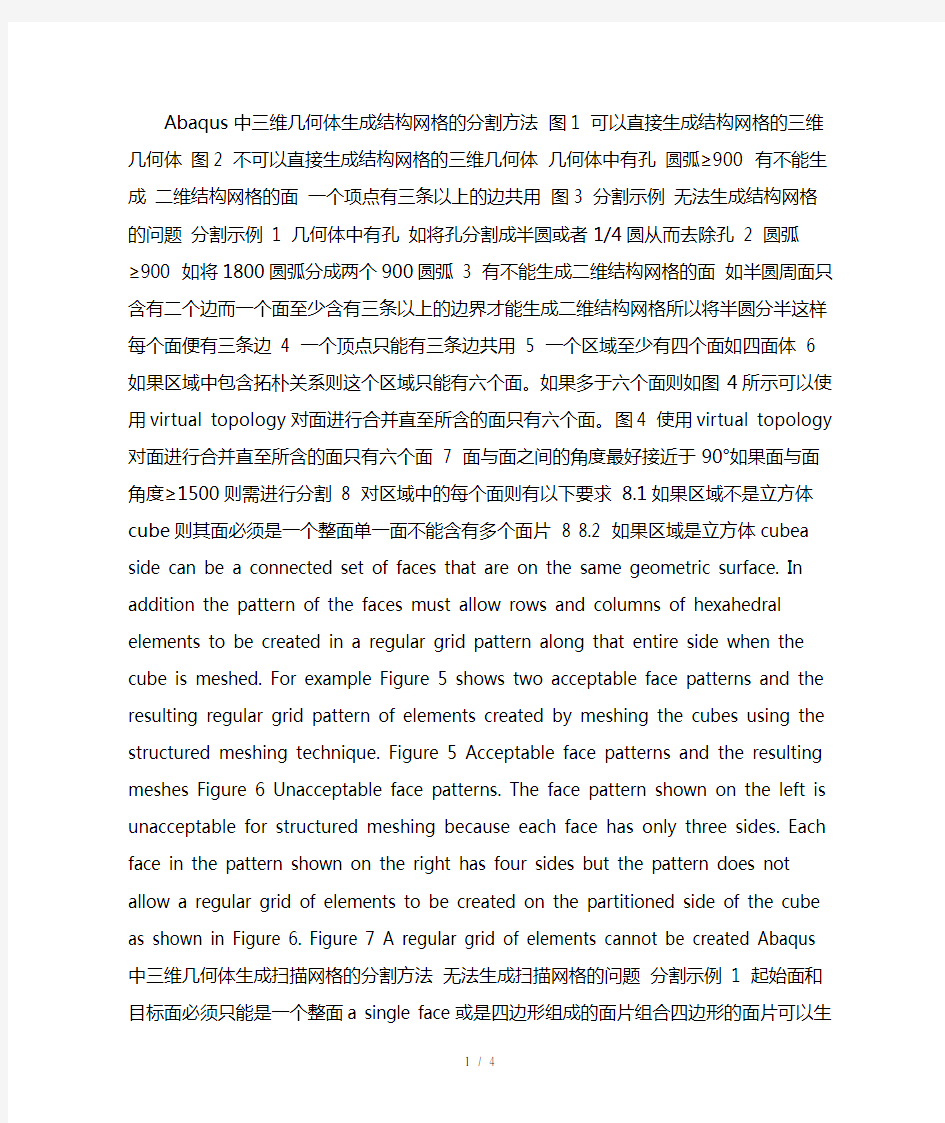Abaqus划分网格技巧小结


Abaqus中三维几何体生成结构网格的分割方法图1 可以直接生成结构网格的三维几何体图2 不可以直接生成结构网格的三维几何体几何体中有孔圆弧≥900 有不能生成二
维结构网格的面一个项点有三条以上的边共用图3 分割示例无法生成结构网格的问题分割示例 1 几何体中有孔如将孔分割成半圆或者1/4圆从而去除孔 2 圆弧≥900 如将1800圆弧分成两个900圆弧3 有不能生成二维结构网格的面如半圆周面只含有二个边而一个面至少含有三条以上的边界才能生成二维结构网格所以将半圆分半这样每个面便
有三条边 4 一个顶点只能有三条边共用 5 一个区域至少
有四个面如四面体6 如果区域中包含拓朴关系则这个区域只能有六个面。如果多于六个面则如图4所示可以使用virtual topology对面进行合并直至所含的面只有六个面。图4 使用virtual topology对面进行合并直至所含的面只有六个面7 面与面之间的角度最好接近于90°如果面与面角度
≥1500则需进行分割8 对区域中的每个面则有以下要求8.1如果区域不是立方体cube则其面必须是一个整面单一面不能含有多个面片8 8.2 如果区域是立方体cubea side can be a connected set of faces that are on the same geometric surface. In addition the pattern of the faces must allow rows and columns of hexahedral elements to be created in a regular grid pattern along that entire side when the cube is meshed. For example Figure 5
shows two acceptable face patterns and the resulting regular grid pattern of elements created by meshing the cubes using the structured meshing technique. Figure 5 Acceptable face patterns and the resulting meshes Figure 6 Unacceptable face patterns. The face pattern shown on the left is unacceptable for structured meshing because each face has only three sides. Each face in the pattern shown on the right has four sides but the pattern does not allow a regular grid of elements to be created on the partitioned side of the cube as shown in Figure 6. Figure 7 A regular grid of elements cannot be created Abaqus中三维几何体生成扫描网格的分割方法无法生成扫描网格的问题分割示例 1 起始面和目标面必须只能是一个整面a single face或是四边形组成的面片组合四边形的面片可以生成规则网格form a regular grid pattern。图1所示provides two examples of acceptable connecting face patterns 图1 provides two examples of acceptable connecting face patterns 图2 Unacceptable connecting face patterns for swept meshing 2 目标面必须只能是一个整面当中没有独立的边和顶点。如图3左边所示可以使用扫描网格因为独立的边和点都在起始面上而不在目标
面上而右边的则不能生成扫描网格因为目标面上有两个面片。图4 显示了变截面网格沿着路径生成的扫描网格。图3 Only the region on the left can be meshed using the swept
meshing technique 图4 Sweeping the mesh along a varying cross-section 可以使用virtual topology工具将目标面上的面片合并起来从而使其可以使用扫描网格命令。图5便显示了使用virtual topology工具合并了目标面的面片为一个整面因为零件中含有virtual topology所以它只能使用advancing front algorithm. 图5 Combining faces makes a part swept meshable 3 对于旋转体截面不能与旋转轴有任何相交的点如图6所示。同样如图7所示截面的一条边与轴线相交但如图8所示mesh the region with hexahedral-dominated elements by generating layers of wedge elements along the axis。图6 The swept meshing technique cannot mesh a part if an isolated point touches the axis of revolution 图7 Abaqus/CAE cannot mesh a region with hexahedral elements if one or more edges lie along the axis of revolution 图8 Abaqus/CAE can mesh the region with hexahedral-dominated elements 具体实例可见帮助中的17.17.7 Sweep meshing a solid revolved region whose profile touches the axis of revolution 4 在旋转面的截面没有与旋转轴相交如果再满足截面完整则可以生成扫描网格。图9的截面完整图10的截面丢失图11只有旋转轴上边没有图9 截面完整图10 截面丢失不能生成扫描网格图11 只有旋转轴上边没有可以生成扫描网格旋转区域使用样条曲线生成的截面spline只有在vertices at each end of the spline
不在旋转轴上才能生成扫描网格。 5 If a part was created by sweeping a cross-section along a sweep path that is composed of a closed spline the resulting part is meshable only if it is split into two or more regions. 6 想生成扫描网格一般来说对几何体的要求是①起始面含有一个以上的面片且面片间的夹角接近于180°②起始面与目标面的连接面a connecting side必须有4个角cornersThe angle at each of the corners must be close to 90°. ③The angles between the source side and each of the connecting sides should be close to 90°. Similarly the angles between the target side and each of the connecting sides should be close to 90°. 从左到右的第三副图显示了a part with three faces on the source side. When the angle decreases between the faces that form the source side the part no longer satisfies the geometric characteristics of a swept meshable region.最右边的图显示了使用virtual topology将起始面上的面片进行合并后可以扫描网格但质量很差。17.13.5 Meshing complex solids with hexahedral elements练习An overview of the methods for partitioning cells 定义分割平面使用基准面分割延伸面分割拉伸或扫描面分割Use n-sided patch Sketch planar partition 71. The Virtual Topology toolset What can I do with the Virtual Topology toolset ①Combine faces or edges②Ignore an edge or a vertex③Automatically combine or ignore
entities④Restore entities To preserve mesh quality edges and faces to be combined should have shallow included angles that are close to 180°. The recommended angle is between 120° and 240°. You can use the angle method to choose only adjacent faces with shallow included angles. For more information see “Using the angle method to select multiple objects” Section
6.2.3. If the included angle at some edges or vertices lies outside this range Abaqus/CAE displays a warning and allows you to remove those edges or vertices from your selection. If you choose to retain the sharp edges the resulting mesh may not lie on a smooth surface. Figure 71–4 illustrates a mesh on a virtual surface that is not smooth. You can use the controls in the Create Virtual Topology dialog box to automatically ignore unnecessary model details based on a set of geometric parameters. You can control the following parameters to determine which features Abaqus/CAE considers merging with surrounding geometry: Edge length、Face size、Face aspect ratio、Face corner angle、Thickness of faces representing small stair features、Corner angle for combining adjacent edges or faces、Angle and radius controls for combining blends chamfered or rounded corners with surrounding faces、Redundant entities.
